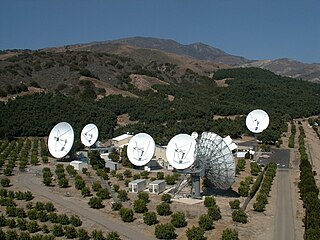
Intelsat S.A. is a multinational satellite services provider with corporate headquarters in Luxembourg and administrative headquarters in Tysons Corner, Virginia, United States. Originally formed as International Telecommunications Satellite Organization, from 1964 to 2001, it was an intergovernmental consortium owning and managing a constellation of communications satellites providing international telecommunications and broadcast services.

A communications satellite is an artificial satellite that relays and amplifies radio telecommunication signals via a transponder; it creates a communication channel between a source transmitter and a receiver at different locations on Earth. Communications satellites are used for television, telephone, radio, internet, and military applications. Many communications satellites are in geostationary orbit 22,300 miles (35,900 km) above the equator, so that the satellite appears stationary at the same point in the sky; therefore the satellite dish antennas of ground stations can be aimed permanently at that spot and do not have to move to track the satellite. Others form satellite constellations in low Earth orbit, where antennas on the ground have to follow the position of the satellites and switch between satellites frequently.
Syncom started as a 1961 NASA program for active geosynchronous communication satellites, all of which were developed and manufactured by the Space and Communications division of Hughes Aircraft Company. Syncom 2, launched in 1963, was the world's first geosynchronous communications satellite. Syncom 3, launched in 1964, was the world's first geostationary satellite.

MCI Communications Corp. was a telecommunications company headquartered in Washington, D.C. that was at one point the second-largest long-distance provider in the United States.

A very-small-aperture terminal (VSAT) is a two-way satellite ground station with a dish antenna that is smaller than 3.8 meters. The majority of VSAT antennas range from 75 cm to 1.2 m. Bit rates, in most cases, range from 4 kbit/s up to 16 Mbit/s. VSATs access satellites in geosynchronous orbit or geostationary orbit to relay data from small remote Earth stations (terminals) to other terminals or master Earth station "hubs".
This is a list of the satellites operated by Optus, an Australian telecommunications company. The satellite communications facility is located at Belrose on Sydney's Northern Beaches. Optus' satellites are divided into 4 classes A, B, C and D. As of April 2014 it owns and operates Optus B3, Optus C1, Optus D1, Optus D2 and Optus D3. Optus A1, Optus A2, Optus A3 and Optus B1 satellites have been retired. Optus has the largest network of satellites in Australia and New Zealand.

Satcom, a portmanteau of satellite communications, was a brand of artificial geo-stationary communications satellites originally developed and operated by RCA American Communications that facilitated wide-area telecommunications by receiving radio signals from Earth, amplifying them, and relaying them back down to terrestrial receivers.
COMSAT is a global telecommunications company based in the United States.
JSAT Corporation (JSAT) was the first private Japanese satellite operator, which owned the JSAT satellites, as well as operated and partially owned the N-Star with NTT DoCoMo. Its origins can be traced to the funding of Japan Communications Satellite Company (JCSAT) and Satellite Japan Corporation in 1985. Both companies merged into Japan Satellite Systems Inc. in 1993. In 2000 the company was renamed as JSAT Corporation and was listed in the First Section of the Tokyo Stock Exchange. On September 1, 2008, the company was merged into the SKY Perfect JSAT Group.
The Intelsat VI series of satellites were the 8th generation of geostationary communications satellites for the Intelsat Corporation. Designed and built by Hughes Aircraft Company (HAC) in 1983-1991, there were five VI-series satellites built: 601, 602, 603, 604, and 605.
Marisat satellites were the first maritime telecommunications satellites and were designed to provide dependable telecommunications for commercial shipping and the U.S. Navy from stable geosynchronous orbital locations over the three major ocean regions. The three Marisat satellites, F1, F2, and F3, were built by Hughes Aircraft Corporation (HAC) for COMSAT Corporation starting in 1973. The satellites were designed to provide maritime telecommunications services in three large ocean areas, the Atlantic Ocean, the Pacific Ocean, and the Indian Ocean, and were located at 72.5° East longitude, 176.5° E, and 345° E in the geosynchronous orbital arc. The three-satellite Marisat system served as the initial INMARSAT constellation.

Robert D. Briskman is Technical Executive of Sirius XM Radio.

Telstar is the name of various communications satellites. The first two Telstar satellites were experimental and nearly identical. Telstar 1 launched on top of a Thor-Delta rocket on July 10, 1962. It successfully relayed through space the first television pictures, telephone calls, and telegraph images, and provided the first live transatlantic television feed. Telstar 2 launched May 7, 1963. Telstar 1 and 2—though no longer functional—still orbit the Earth.
Intelsat 23 is a communications satellite run by Intelsat which will provide communications services for the Americas, Western Europe and Africa. It is in a geosynchronous orbit located at 53° west and will replace Intelsat 707. It was built by Orbital Sciences and has a designed life of 15 years.

Intelsat II F-1, also known as Blue Bird was a communications satellite operated by Intelsat. Launched in 1966 it was intended for operations in geostationary orbit over the Pacific Ocean to provide a communications link between Australia and the United States, however a malfunction prevented the satellite from reaching its planned orbit.
The JSAT constellation is a communication and broadcasting satellite constellation formerly operated by JSAT Corporation and currently by SKY Perfect JSAT Group. It has become the most important commercial constellation in Japan, and fifth in the world. It has practically amalgamated all private satellite operators in Japan, with only B-SAT left as a local competitor.
JCSAT-4 was known as JCSAT-R until it was sold to INTELSAT in 2009. It is a geostationary communications satellite designed and manufactured by Hughes on the HS-601 satellite bus. It was originally ordered by JSAT Corporation, which later merged into the SKY Perfect JSAT Group. It has a mixed Ku-band and C-band payload and was used as an on orbit spare.
JCSAT-3 was a geostationary communications satellite designed and manufactured by Hughes on the HS-601 satellite bus. It was originally ordered by JSAT Corporation, which later merged into the SKY Perfect JSAT Group. It has a mixed Ku-band and C-band payload and operated on the 128° East longitude until it was replaced by JCSAT-3A.
SBS 6 was a geostationary communications satellite designed and manufactured by Hughes on the HS-393 platform. It was originally ordered by Satellite Business Systems, which later sold it to Hughes Communications and was last used by Intelsat. It had a Ku band payload and operated on the 95°W longitude.
N-STAR c, is a geostationary communications satellite originally ordered by NTT DoCoMo and later fully acquired by SKY Perfect JSAT Group. It was designed and manufactured by Lockheed Martin, which acted as prime, developed the payload and did the final integration and testing, and Orbital Sciences Corporation, which supplied the satellite bus on the GEOStar-2 platform and procured the launch services. It had a launch weight of approximately 1,645 kg (3,627 lb), and a 15-year design life. Its payload is composed of 1 C-band, and 20 S-band transponders and its stationed in the 136° East longitude.








